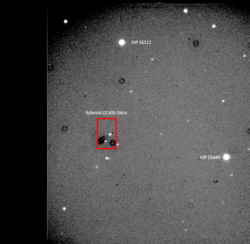astro.wikisort.org - Asteroid
3169 Ostro, provisional designation 1981 LA, is a Hungaria family asteroid from the innermost regions of the asteroid belt, approximately 5 kilometers in diameter.
 Ostro imaged by the 0.7-m telescope at Heidelberg Observatory | |
| Discovery [1] | |
|---|---|
| Discovered by | E. Bowell |
| Discovery site | Anderson Mesa Stn. |
| Discovery date | 4 June 1981 |
| Designations | |
MPC designation | (3169) Ostro |
Named after | Steven J. Ostro (planetary scientist)[2] |
Alternative designations | 1981 LA |
Minor planet category | main-belt · (inner) [1] · Hungaria [3][4] |
| Orbital characteristics [1] | |
| Epoch 4 September 2017 (JD 2458000.5) | |
| Uncertainty parameter 0 | |
| Observation arc | 63.43 yr (23,166 days) |
| Aphelion | 2.0184 AU |
| Perihelion | 1.7652 AU |
Semi-major axis | 1.8918 AU |
| Eccentricity | 0.0669 |
Orbital period (sidereal) | 2.60 yr (950 days) |
Mean anomaly | 120.41° |
Mean motion | 0° 22m 43.68s / day |
| Inclination | 24.906° |
Longitude of ascending node | 96.376° |
Argument of perihelion | 32.622° |
| Physical characteristics | |
| Dimensions | 4.662±0.118[5] 5.27 km (derived)[4] |
Synodic rotation period | 6.503±0.003[6] |
Geometric albedo | 0.5152 (derived)[4] 0.960±0.023[5] |
Spectral type | TS (Tholen)[1] Xe (SMASS)[1] B–V = 0.771[1] U–B = 0.306[1] |
Absolute magnitude (H) | 12.73[1][4] |
The asteroid was discovered on 4 June 1981, by American astronomer Edward Bowell at Lowell's Anderson Mesa Station in Flagstaff, Arizona,[3] and named after planetary scientist Steven J. Ostro at JPL.[2]
Orbit and classification
Ostro is a member of the Hungaria family, which form the innermost dense concentration of asteroids in the Solar System. It orbits the Sun at a distance of 1.8–2.0 AU once every 2 years and 7 months (950 days). Its orbit has an eccentricity of 0.07 and an inclination of 25° with respect to the ecliptic.[1]
Physical characteristics
In the Tholen and SMASS taxonomy, Ostro is classified as a TS-type and Xe-type asteroid, respectively.[1] It has also been characterized as an E-type asteroid.[4]
According to the survey carried out by NASA's Wide-field Infrared Survey Explorer with its subsequent NEOWISE mission, Ostro measures 4.662 kilometers in diameter and its surface has an outstandingly high albedo of 0.960.[5] The Collaborative Asteroid Lightcurve Link derives an albedo of 0.5152 and a diameter of 5.27 kilometers with an absolute magnitude of 12.73.[4]
In May 2012, a rotational lightcurve of Ostro was obtained from photometric observations by American astronomer Brian Warner. Lightcurve analysis gave a well-defined rotation period of 6.503 hours with a brightness amplitude of 0.79 magnitude (U=3).[6]
Naming
This minor planet was named after American planetary scientist Steven J. Ostro at the Jet Propulsion Laboratory of the California Institute of Technology.[2] The approved naming citation was published by the Minor Planet Center on 14 April 1987 (M.P.C. 11749).[7]
References
- "JPL Small-Body Database Browser: 3169 Ostro (1981 LA)" (2017-06-04 last obs.). Jet Propulsion Laboratory. Archived from the original on 23 April 2017. Retrieved 15 June 2017.
- Schmadel, Lutz D. (2007). "(3169) Ostro". Dictionary of Minor Planet Names – (3169) Ostro. Springer Berlin Heidelberg. p. 262. doi:10.1007/978-3-540-29925-7_3170. ISBN 978-3-540-00238-3.
- "3169 Ostro (1981 LA)". Minor Planet Center. Retrieved 15 June 2017.
- "LCDB Data for (3169) Ostro". Asteroid Lightcurve Database (LCDB). Retrieved 15 June 2017.
- Masiero, Joseph R.; Mainzer, A. K.; Grav, T.; Bauer, J. M.; Cutri, R. M.; Dailey, J.; et al. (November 2011). "Main Belt Asteroids with WISE/NEOWISE. I. Preliminary Albedos and Diameters". The Astrophysical Journal. 741 (2): 20. arXiv:1109.4096. Bibcode:2011ApJ...741...68M. doi:10.1088/0004-637X/741/2/68. Retrieved 15 June 2017.
- Warner, Brian D. (October 2012). "Asteroid Lightcurve Analysis at the Palmer Divide Observatory: 2012 March - June". The Minor Planet Bulletin. 39 (4): 245–252. Bibcode:2012MPBu...39..245W. ISSN 1052-8091. Retrieved 15 June 2017.
- "MPC/MPO/MPS Archive". Minor Planet Center. Retrieved 15 June 2017.
External links
- Lightcurve plot of 3169 Ostro, Palmer Divide Observatory, B. D. Warner (2012)
- Asteroid Lightcurve Database (LCDB), query form (info Archived 16 December 2017 at the Wayback Machine)
- Asteroids with Satellites, Robert Johnston, johnstonsarchive.net
- Dictionary of Minor Planet Names, Google books
- Asteroids and comets rotation curves, CdR – Observatoire de Genève, Raoul Behrend
- Discovery Circumstances: Numbered Minor Planets (1)-(5000) – Minor Planet Center
- 3169 Ostro at AstDyS-2, Asteroids—Dynamic Site
- 3169 Ostro at the JPL Small-Body Database
На других языках
[de] (3169) Ostro
Vorlage:Infobox Asteroid/Wartung/MiAnomalieVorlage:Infobox Asteroid/Wartung/MiBewegung- [en] 3169 Ostro
Другой контент может иметь иную лицензию. Перед использованием материалов сайта WikiSort.org внимательно изучите правила лицензирования конкретных элементов наполнения сайта.
WikiSort.org - проект по пересортировке и дополнению контента Википедии